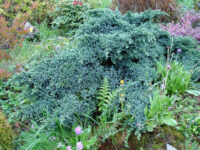Juniperus squamata 'Blue
Star'
 The
Blue Star Juniper is one of the most popular compact or
small bush junipers for garden plantings everywhere in
the temperate world, truly a 'star' of a plant.
The
Blue Star Juniper is one of the most popular compact or
small bush junipers for garden plantings everywhere in
the temperate world, truly a 'star' of a plant.
'Blue Star' has a bushy, loosely-dome-shaped
form, with some projecting shoots. Sometimes it is denser
and more uniform than in the illustration here.
The Blue Star juniper has prickly
'juvenile'-type foliage of a silvery-blue colour. It is
usually dense and well-furnished. The growth rate is fairly
slow, a plant making up to 3 feet (1 metre) across in
ten years, and a little less high.
The Blue Star Juniper originated
as a 'sport' on a bush of the older Juniperus squamata
variety 'Meyeri' and quickly became a real star of the
conifer world upon its release in the 1970's. Unlike 'Meyeri',
'Blue Star' does not shed its lower leaves to leave bare
patches, and it is much dwarfer ('Meyeri' can grow three
times as high in the same space of time).
Apart from with the cultivar
'Meyeri' the same kind of silvery-blue prickly foliage
may be found in the 'Blue Star'-like but vigorously spreading
groundcover form Juniperus squamata 'Blue Carpet'. A similar
cultivar with angled main branches that weep at the ends
to form curving 'legs' has been named 'Blue Spider', and
more vigorous 'squarer' forms with horizontal growth in
tiers may be found in 'Blue Swede' and 'Hunnetorp' (some
claim these last two cultivars as synonymous forms, but
with us 'Hunnetorp' is less sideways spreading).
Growing Conditions
In general the Blue Star juniper
should be grown in free-draining soil, and does fairly
well in poor or impoverished soils. It will not tolerate
boggy or water-logged conditions. Blue Star will grow
in either alkaline or acidic soils. It needs an open,
sunny aspect away from the floppy foliage of large herbaceous
plants or large shrubs.
Use in the Garden
Because of its slow speed of
growth and striking appearance, the Blue Star juniper
mixes well with alpines and heathers. It also looks good
in gravel gardens and close to the edge of paving. Red
or yellow brick would be an effective contrast with it,
as are yellow-leaved forms of winter flowering heather,
Erica carnea, such as 'Foxhollow', 'Altadena' and the
like. A single specimen of 'Blue Star', or even a scattered
group would look stunning with these yellow-foliaged heathers
growing around and between them.
Other alternatives for a
similar effect:
Cultivars with similar foliage
but very different growth habits have been discussed above.
For a compact, bushy plant of slow growth Juniperus communis
'Berkshire' (named after the Berkshire Mountains in the
USA and not the English county - although these mountains
themselves were most likely named after the English county!)
could be considered. This cultivar is silvery-green/grey,
with bronze or mauve tints in the winter. It is slower
growing than Blue Star and perhaps more suitable amongst
select alpines or in a trough.
Various dwarf spruces would
give a loosely similar effect to 'Blue Star' in the garden,
at least from a distance. Picea sitchensis 'Papoose',
originating from Canada, is a mound of spiky silvery-green
foliage, wonderful in the springtime in particular. More
blue is Picea pungens 'Globosa Nana'.
Using Junipers
in Your Garden
How to use junipers in a garden - avoid 'design mistakes'
but use these striking plants to their full advantage.
How to grow Junipers
in your garden
How to grow junipers in your garden - their cultivation
requirements.
Juniper Resources &
Links
Good juniper resources and links.
Link to this Junipers
site
Add an extra resource about juniper trees for your visitors.
What
are Juniper trees?
Go
Back
Juniper
Trees
Disclaimer
| Link
to Us | Contact
Us | Terms of Use
Text and Images Copyright
©  junipertrees.com and on behalf of individual copyright
owners.
junipertrees.com and on behalf of individual copyright
owners.
All Rights Reserved.
This Blue Star juniper page
belongs to http://www.junipertrees.com/